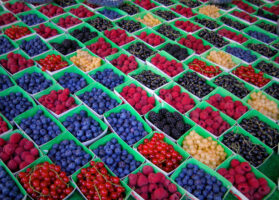Agronometrics in Charts: Oversupply of Grapes in the US Market Sends Prices Plummeting
In this installment of the ‘Agronometrics In Charts’ series, Sarah Ilyas studies the state of the US grape market. Each week the series looks at a different horticultural commodity, focusing on a specific origin or topic visualizing the market factors that are driving change.
“The U.S. is currently flooded with grapes. In Chile, we’re around 80 percent done with harvest and most of the fruit for us has been loaded. There’s a lot of fruit on the water and a lot of fruit arriving into the U.S market mainly,” says Nicolas Damm of Rio Blanco.
Due to strikes throughout Peru that occurred in January, harvesting and loading were both delayed. These late Peruvian shipments are not harmful for the US market per se, however, given the fact that Chile is also in the game and has been loading gradually increasing volumes to the United States over the past few weeks, has raised concerns. The Chilean harvest has been concentrated into a shorter shipping window after a heat wave affected its crop. “The season started slow from the north but then harvests came on very concentrated. The fruit had lighter bunches caused by this heat and the harvest of each variety finished earlier and with less volume on each variety. It’s also concentrated, probably due to the change in varieties,” Damm says.

Source: USDA Market News via Agronometrics.
(Agronometrics users can view this chart with live updates here)
In Week 11, the US market recorded a total incoming volume of 33K tonnes, a 90% increase compared to the same period last year. This significant surge in volumes has occurred during the span of only four weeks. Loadings of Chilean table grapes to the United States through Week 3 were significantly lower compared to last year’s volumes. The impact of these hefty volumes began to be felt in the market during Week 5, causing market prices to decline.

Source: USDA Market News via Agronometrics.
(Agronometrics users can view this chart with live updates here)
In terms of demand, Damm believes importers in the U.S. are apprehensive about huge arrivals. “Cold storages are pretty filled up in the East Coast, near Philadelphia especially. Apparently, there’s quite a bit of volume of weak fruit. The heat also had its toll on sizing,” he says. He anticipates that the impact on pricing could persist, stock levels are now mounting with the result that selling prices are falling. “Once retailers have cleared their expensive inventories, we should expect lower retail prices. In the last few weeks, there has been less volume so that’s a light at the end of the tunnel. These huge weekly arrivals will not go on for long. Last week and this week are probably peak weeks of arrival and from then on, there will be lower volumes from Chile and Peru,” Damm claims.
While underscoring the challenges being faced by the US grape industry this season, Damm also sheds light on some headway that has been made in logistics. “The fruit has been loaded on time here, the ports have worked well, the vessels are on schedule and loading on time. Transits have been close to normal and the port situation in the U.S. is pretty much back to normal,” he says.

Source: USDA Market News via Agronometrics.
(Agronometrics users can view this chart with live updates here)
In our ‘In Charts’ series, we work to tell some of the stories that are moving the industry. Feel free to take a look at the other articles by clicking here.
All pricing for domestic US produce represents the spot market at Shipping Point (i.e. packing house/climate controlled warehouse, etc.). For imported fruit, the pricing data represents the spot market at Port of Entry.
You can keep track of the markets daily through Agronometrics, a data visualization tool built to help the industry make sense of the huge amounts of data that professionals need to access to make informed decisions. If you found the information and the charts from this article useful, feel free to visit us at www.agronometrics.com where you can easily access these same graphs, or explore the other 21 commodities we currently track.
Written by: Sarah Ilyas






